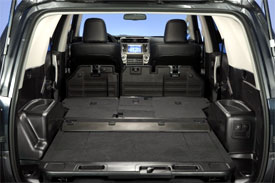2010 Toyota 4Runner
The Toyota 4Runner is a legend. It was the first import brand SUV to give Detroit four-by-fours a serious run for their customers. Since 1984, the 4Runner has delivered rugged and reliable performance, and developed a legion of faithful in the process. But today, most utility buyers have traded prowess for comfort in the form of crossovers. Still, the all-new fifth generation 4Runner continues to play its familiar tune. But, are buyers still listening?
For starters, the 2010 Toyota 4Runner fits the visual bill of a capable SUV perfectly. The two-box lines are no-nonsense, from its gaping, blacked-out grille and big, angular headlights perched high atop the blunt front end, to the stout spoiler-topped liftgate, with taillights pushed to the corners.
The 4Runner we wrung out was the new off-road-oriented “Trail” variant, which splits the difference between the entry-level SR5 and ornamented Luxury, and gives the front fascia an even greater stylistic dose of utility. Bulging fenders add to the muscular character, housing the Trail’s stout 265/70 tires on 17-inch rims.
 On rear-wheel drive 4Runners, standard power now comes from the Tacoma’s 2.7-liter, twin-cam four, generating an underwhelming 157 horsepower and 178 pound-feet of torque.
On rear-wheel drive 4Runners, standard power now comes from the Tacoma’s 2.7-liter, twin-cam four, generating an underwhelming 157 horsepower and 178 pound-feet of torque.
In a further nod to economy, a thoroughly reworked 4.0-liter V6 replaces last year’s 4.7 V8 as the top engine. Rated at 270 horsepower and 278 foot-pounds of torque, it outclassed the old V8 in horsepower if not in torque.
Still, we found the V6 to be plenty capable: zero to 60 in 7.8 seconds. Plus, it never left us stranded, even in record-breaking snow storms, and it was impressively smooth. Off-road purists will be disappointed that, once again, there is no manual transmission. The V6 mates to a five-speed automatic, while the four gets by with only four.
Government Fuel Economy ratings for the base four-cylinder 4X2 are 18 City/23 Highway. But the V6 4x2 is almost the same. And even our V6 4X4 rates close at 17 City/ 22 Highway. Our test loop was spot on at 19.8 miles per gallon of regular gas. Still, our V6 4Runner earns a fairly thirsty Energy Impact Score of 18 barrels of oil consumed annually, and a yearly Carbon Footprint of 9.6 tons of CO2.
For 2010, the 4Runner continues to share its heavily-reinforced, fully-boxed, ladder-type frame with the FJ Cruiser. Our Trail 4x4 came equipped with the optional Kinetic Dynamic Suspension System, which can disengage front and rear anti-roll bars at speeds up to 40 mph, ensuring as much tread contact as possible over rough, uneven terrain.
Four-wheel drive SR5 and Trail models feature an off-road capable part-time, two-speed four-wheel drive system with a rear locker and low-range Crawl Control, while Limited models are full-time four-wheel drivers with a locking center differential. All 4x4s use Toyota’s A-TRAC power distribution system, which routes power to whichever wheel needs it the most.
On the flip side, our Trail grade 4Runner’s Multi-Terrain Select allows some wheel-slip when more traction won’t solve the problem.  All 4Runners come with Hill Start Assist, and 4x4s add Hill Descent Control.
All 4Runners come with Hill Start Assist, and 4x4s add Hill Descent Control.
Coil springs and gas shocks work in conjunction with a double-wishbone, fully-independent front suspension and four-link solid-axle rear setup. With the V6 and trailer hitch, the 4Runner is tow-rated for 5,000 pounds.
With no meaningful change in exterior size, the interior also delivers about the same total space as before. Yet, it seems roomier thanks to a design treatment that has a lot in common with the Lexus GX460, especially the upright, truck-like dash with tall center stack and beefy controls.
Gauges, however, have a decidedly sporty flare with a triple pod format. The shrouds really reduce glare, and there’s even a trendy “Eco” indicator.
Front seats are wide and well padded, with our Trail’s standard cloth covered cushions including power lumbar for the driver. Trail trim includes a useful backup camera display in the rear view mirror, which moves to the center stack if you order our 4Runner’s $2,400 voice-activated navigation system.
4Runners come standard as two-row five-seaters. The second row split bench handles three adults well. A third-row split bench is optional. The 4Runner also handles cargo well. All seats down deliver a competitive 90 cubic feet. Our tester’s trick 440-pound capacity slide deck makes loading and unloading a cinch.
Sounds like a lot of SUV-and it is, but with prices to match. The base SR5 4X2 sits at $28,300 to start; the V6 is still under thirty grand. But our Trail 4X4 jumps to $36,500. And the top drawer Limited begins at $38,565.
The market for traditional SUVs continues to shrink. And, when the Ford Explorer moves to a car-like chassis next year, the body-on-frame 4Runner will have few high volume rivals. Maybe that’s why Toyota left the 4Runner heritage intact. In a world of utilities gone soft, the better-than-ever 4Runner remains a standard for the true SUV.
Specifications
- Engine: 4.0-Liter V6
- Horsepower: 279
- Torque: 278 Lb Feet
- 0-60 MPH: 7.8 Seconds
- EPA: 17 MPG City/ 22 MPG Highway
- Mixed Loop: 19.8 MPG
- Energy Impact: 18.0 Barrels Oil/Yr
- CO2 Emissions: 9.6 Tons/Yr






